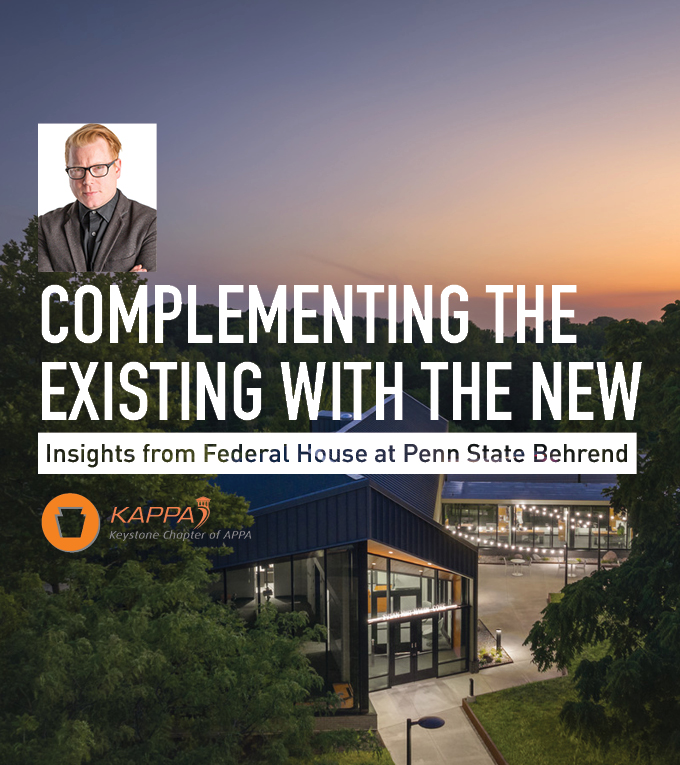Insights
Aug 20, 2024 _ insights
Complementing the Existing with the New: Insights from Federal House at Penn State Behrend
Student interaction with campus buildings is a key part of their college experience. Facilities professionals in higher education play an important role in the planning, creation, and maintenance of campus facilities that in turn support the success of students and the institution.
I recently attended the spring meeting of KAPPA, the Keystone (Pennsylvania) Chapter of APPA (formerly known as the Association of Physical Plant Administrators) where I presented about our renovation of and addition to Federal House at Penn State Behrend, which opened in 2022.
GBBN was engaged by Penn State Behrend to conduct a feasibility study in 2018 for adding the Center for Community Outreach Research and Evaluation (CORE) to the existing Federal House Building on the edge of campus. The Federal House is the oldest brick structure in the area and was a stop on the Underground Railroad. As part of the project, the new home for CORE adds 10,000 square feet to the existing building and provides much needed classroom, office, and meeting space. CORE, is an initiative of Penn State Behrend’s School of Humanities and Social Sciences and fosters positive youth development and a culture of hope through mentoring and education programs. Creating a space of inclusion and security, the design communicates to its young visitors that they are valued. While the building’s large, glass walls draw a compelling contrast to the solidity of the Federal House, its dark gray metal panels echo the historic building’s gabled roof. The addition is softened by a warm wood wrap that marks its entrance, welcoming visitors, so whether they’re headed to mentoring sessions in a small meeting room or a program in the 80-person multipurpose space just inside, they know that this place is for them.
In addition, the building addresses the sometimes-harsh climate of Erie (that can get up to 10 feet of snow per season) by utilizing a roof to wall water-shedding standing seam metal panel that directly funnels to a ground gutter system. Often used in Scandinavia, this approach of angled roofs leading to a ground gutter can shed snow and water away from the building before freeze and thaw can cause building and gutter damage.
The presentation shared details of the project including:
- How the mission of CORE influenced the types of activities to be accommodated in their new facility.
- The relationship between the existing, historic Federal House building and site and the significance of the place and its role on campus.
- How the role of donor engagement during the feasibility study and programming helped map out the budget, size, and project drivers in the project planning
- Lessons learned from the project in planning, construction, and post occupancy.
See the full presentation here.
 Matthew Plecity, AIA, ASLA is a principal at GBBN. An architect with a landscape architecture background, Matt leverages his understanding of site and context to design buildings with strong relationships to their environments. As part of the leadership team for GBBN’s Higher Education Market, he regularly shares his insights into campus design and sustainability at regional, national, and international conferences. Matt loves collaborating with clients, colleagues, and consultants to build bold ideas like University of Pittsburgh’s Hillman Library renovation, Penn State Behrend’s Federal House, and Carnegie Library of Pittsburgh’s Library of Accessible Media for Pennsylvanians (LAMP).
Matthew Plecity, AIA, ASLA is a principal at GBBN. An architect with a landscape architecture background, Matt leverages his understanding of site and context to design buildings with strong relationships to their environments. As part of the leadership team for GBBN’s Higher Education Market, he regularly shares his insights into campus design and sustainability at regional, national, and international conferences. Matt loves collaborating with clients, colleagues, and consultants to build bold ideas like University of Pittsburgh’s Hillman Library renovation, Penn State Behrend’s Federal House, and Carnegie Library of Pittsburgh’s Library of Accessible Media for Pennsylvanians (LAMP).




